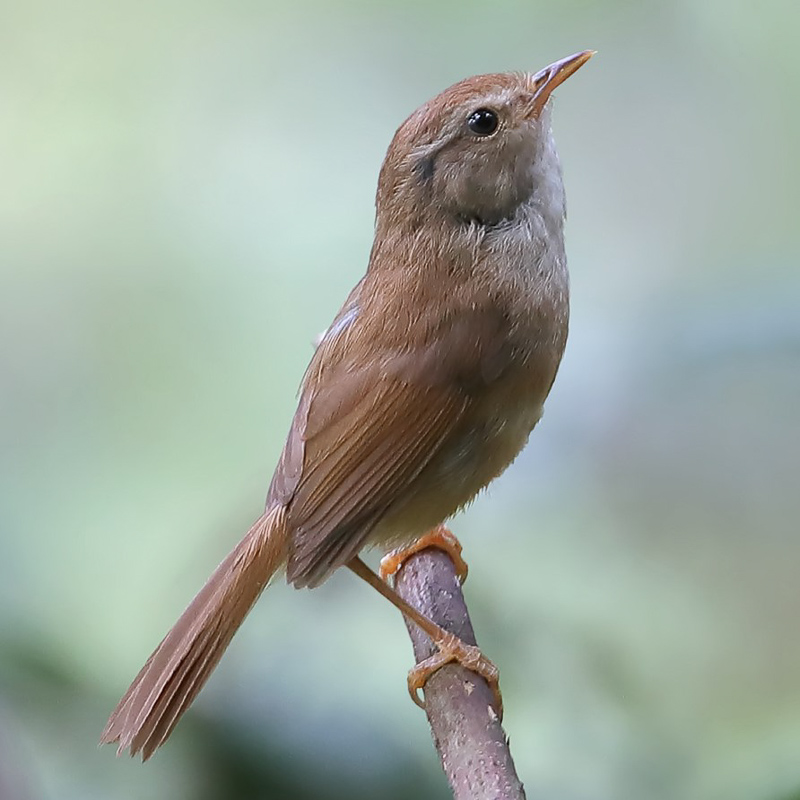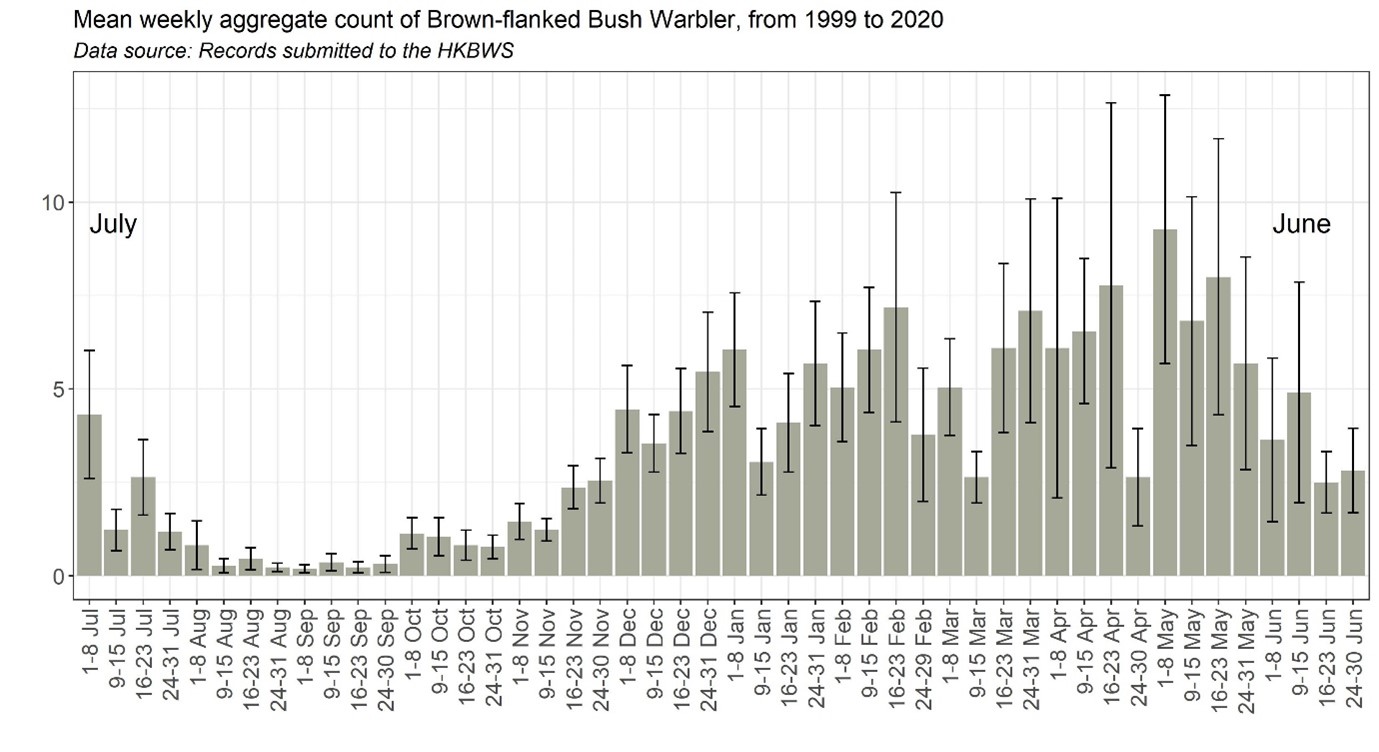Brown-flanked Bush Warbler Horornis fortipes 強腳樹鶯
Category I. Common winter visitor to areas of open-canopy shrub, rank grass, woodland edge and other open-canopy but densely vegetated areas.
IDENTIFICATION

Jun. 2021, Michelle and Peter Wong.
11-12 cm. Small and pot-bellied with a relatively long but flimsy tail and a lack of striking plumage features. The supercilium is indistinct dull buffish, more obvious over the lores, the eye stripe is broad but not especially dark and the ear coverts are paler than the crown. The upperparts vary from rufous-brown to grey-brown depending on age and plumage condition. Outer webs to flight feathers are warm brown. Underparts are dull whitish washed pale brown on the chest and greyish on the flanks. The undertail coverts are warmer in tone.
VOCALISATIONS
Usually located by call in the non-breeding season and its striking song in summer. The call is a fairly hard and thin ‘chak’ or ‘tak’, often rapidly, though irregularly repeated. More excited birds may run ‘tak’ calls together in a short rattle.
The song is a loud, explosive and striking. It begins with a pure note of even pitch held for 1-2 seconds, followed by a variable crescendo.
In breeding areas in summer may be heard the metallic breathless call of fledged juveniles, which can sound similar to Scaly-breasted Munia.
DISTRIBUTION & HABITAT PREFERENCE
Unrecorded in the 1993-96 breeding bird survey, the breeding range increased rapidly to encompass 6.3% of 1km squares in the 2016-19 survey. There are two strongholds: the Tai Mo Shan massif and adjacent Lam Tsuen CP, and the contiguous country park area of Pat Sin Leng and Plover Cove; elsewhere it was recorded in a small number of squares on Lantau, the Kowloon / Ma On Shan range of hills and Sai Kung East CP.
The first report of song in suitable breeding habitat was at 790m on 17 April 1999 on Tai Mo Shan. Breeding was first confirmed on 5 July 2003 when two dependent fledged juveniles were seen. The first double-figure count of singing birds was made on 29 April 2005, while the highest count is 32 on 23 May 2016 (though, of course, such counts reflect the area of coverage rather than actual density). Singing birds have been recorded at 700-900m in the breeding season.
The first report suggesting breeding on Pat Sin Leng was of four birds in song on 5 February 2009, while 29 singing birds were present later in the month on the 25th, indicating that a substantial breeding population was present and probably had been for some years. The highest subsequent count there was of 51 birds along the main ridge and approach path on 3 April 2018. During the 2009 breeding season singing birds were in song at 330-600m asl, significantly lower than on Tai Mo Shan.
It breeds in areas of dense shrubland or shrubland / grassland. In the non-breeding season, it occurs in areas of rank grass, dwarf bamboo, shrubland / grassland in areas generally below 500m, although occasionally above (one was in song at 600m on Nei Lak Shan, Lantau on 31 December). It may also be encountered in forest clearings, along woodland paths or at the edge of closed-canopy habitats.
The percentage of occupied 1km squares increased from 6.0% to 8.4% between the winter atlas surveys of 2001-05 and 2016-19. Most birds were present at low elevations in the northeast New Territories, Tai Mo Shan massif, Kowloon Hills, Ma On Shan, Sai Kung West and East CP and Lantau. It shows a preference for sub-montane dry areas, with very few recorded from the Deep Bay area.
OCCURRENCE
September appears to mark the transition from records related to breeding birds and their progeny, as there were only five records in that month away from known breeding sites during 1999-2020. Numbers slowly increase during October and more rapidly in November, after which the wintering population appears stable until February (Figure 1). An increase of records in March reflects increasing frequency of song, while the highest numbers are reported in April and May when the loud song allows easy survey of large upland areas, with the highest count being 51 along the Pat Sin Leng ridge on 3 April 2018.
The first record of this species occurred at Kadoorie Beach on 1 December 1983 (Chalmers and Viney 1985). Subsequently, two records during December 1988 were followed by a widespread influx in December 1989, when observers had the chance to become familiar with the call, behaviour and habitat preference of this species. Since that winter, it has been recorded annually, initially as a non-breeding visitor and after 1999, as a species breeding in montane shrubland.
BREEDING
Song can be heard in most months, but most often during February to June and least from August to October. Up to three dependent juveniles have been recorded from 13 May to 1 August.
BEHAVIOUR, FORAGING & DIET
Secretive and shy, solitary in the non-breeding season. Usually located by its distinctive vocalisations, either call or song. Constantly on the move through vegetation near ground level as it forages. Food items appear to be invertebrates and their larvae or eggs.
RANGE & SYSTEMATICS
Four subspecies are recognised across its range, which extends from the western Himalayas east to much of south China. The taxon occurring in HK is C. f. davidianus, which breeds in China from southeast Gansu and south Shaanxi south through hill areas in much of the country to northeast Indochina. C. f. robustipes occurs in Taiwan, while the remaining two subspecies, the nominate and C. f. pallida, breed in the Himalayas (Kennerley and Pearson 2010, Liu and Chen 2020).
CONSERVATION STATUS
IUCN: Least Concern. Population trend decreasing.
Figure 1.

Chalmers, M. L. and C. A. Viney (1985). Systematic list 1983. Hong Kong Bird Report 1983: 6-36.
Kennerley, P. and D. Pearson (2010). Reed and Bush Warblers. Christopher Helm, London.
Liu, Y. and Y. H. Chen (eds) (2020). The CNG Field Guide to the Birds of China (in Chinese). Hunan Science and Technology Publication House, Changsha.

